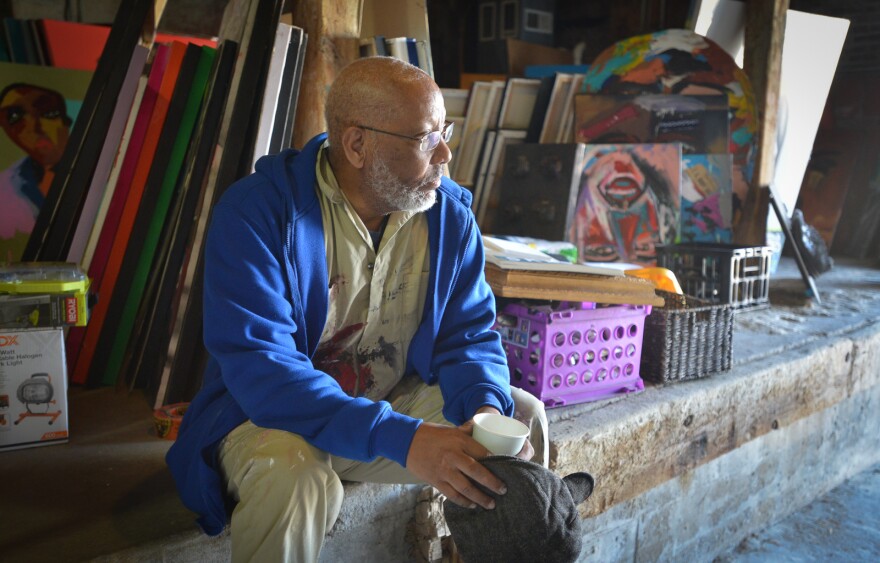Harold Smith's paintings are easy to spot in the TV show “Bel-Air,” a reboot of the 1990s sitcom “The Fresh Prince of Bel-Air.”
In the first episode, there's one painting — a cluster of mask-like faces — on the wall as a teenager named Will walks into the dining room of his aunt and uncle’s Bel Air mansion. In the fourth episode, there are smaller paintings, colorful portraits with broad brushstrokes — inside a record store.
"Bel-Air" creator Morgan Cooper grew up in Kansas City and wanted to feature local artists on the show, including designers, musicians and painters like Smith.
“It feels good,” says Smith. “I just want to keep making this work. To me, at this point in life, it's more about the work than anything else.”
At 59, Smith is having a mid-career moment.

Smith’s paintings are also on view at the Nelson-Atkins Museum of Art in Kansas City in a group exhibition of African-American artists called “Testimony.” And in a recent “new to view” exhibition at the Nerman Museum of Contemporary Art in Overland Park.
Both museums collect his work.
Smith has painted in Kansas City for decades. This kind of success, he says, feels like a long time coming.
“I mean, I’m happy about it,” he says. “I think my reaction would be different maybe if I was 20, 30 years younger.”
He adds, “I think that when you're later in life and these opportunities open up, it's good, you grab 'em. But in the back of your mind, you kind of know you're like running against the clock, so you want to maximize it.”

A self-taught artist, Smith’s Kansas City, Kansas, house doubled as his studio.
In February, he moved into a large studio space at 1708 Campbell through a three-year artist residency at Studios, Inc. And, with an unrestricted cash grant of $10,000 from a Charlotte Street Foundation visual artist award, he’s able to buy new materials and has more room to use them.
“You take that one right there, the canvas with spray paint,” he says, pointing to an 8 x 10-foot work with a bright red background. “There's just no way I could have done that in my living room. Can you imagine spray paint? My whole house would've been red.”
Finally, he says, he's been able to do things he's wanted to do for years.

This professional success comes after the turbulence of the COVID-19 pandemic and the protest movement sparked by the death of George Floyd. Smith designed one of the Black Lives Matter murals painted in 2020 on Kansas City streets.
Across the country, and in the Kansas City metro, the pandemic hit Black communities hard.
“It just eviscerated northeast Kansas City, Kansas, we lost so many people,” he says, recalling an eight-week span in fall 2020. “It was, like, classmates. If it wasn't somebody I knew personally, it was their brother, their sister, their mama, their daddy, their daughter.”

Smith kept teaching art classes at Lincoln Middle School. He’s been a teacher for three decades, also at Manual Career and Technical Center. But last year, in August, after in-person classes started up full-time, he says he started having panic attacks, something he hadn’t experienced before.
“Just these overwhelming feelings of dread. And it was bad,” he says. “I think it was lack of closure over just the death (during the pandemic). I still, you know, I hardly talk about it today.”
He made plans to retire in December, and says he soon knew it was the right decision.
“The guy that they interviewed that eventually took the position, he came in for an interview to meet me — former student,” he says. “And he hung around for about a week, coming in a lot, and the kids just took to him.”
Sometimes, he says, it's important to just get out of the way.
“So somebody younger can come in here and get their shot, you know?”

Smith hopes to continue to mentor younger artists as he keeps doing his own work.
His current success feels all the more significant considering his show in 2019 at the Nerman Museum. It paired Smith’s paintings with poetry by Glenn North and explored the invisibility of Black men. It was titled “Can You See Me?”
“I am being seen more now, but I think that it doesn't take away from the mission,” he says. “The narrative is that I'm trying to speak for men of color, Black men. A lot of us have not been seen. We're still not being seen.”

But now, with more time to create, a bigger place to do it and additional resources, he’s pushing back against pandemic weariness — with more color.
"Before the pandemic, I had done a series of black-on-black artworks and I might have done one or two after the pandemic started," he says. "But I just feel a deeper desire to have a more enthusiastic use of color, I guess, exuberance. I think it's more vibrant."






